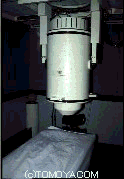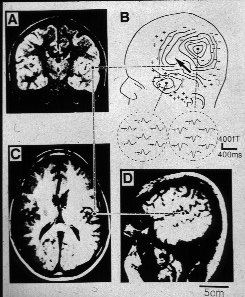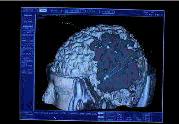 超伝導量子干渉装置 -----SQUID
超伝導量子干渉装置 -----SQUID九州大学附属病院に設置された神経磁気診断装置。中央の円筒形の下端に、生体から発生する微弱な磁気を計測するSQUIDが37個設置されており、それらは円筒形の格納容器の中の液体ヘリウムによって絶対温度4度に保たれている。記録は外界の電磁気を遮蔽するシールドルーム内で行われる。
37 channel SQUID system is placed on the bottom of container, which record extremely weak magnetic signal emitted from the brain. SQUID system is cooled down to 4 degrees Kelvin by liquid Helium inside the container. Recording is performed inside the shilded room which attenuated the outcoming magnetic and electric noise.
 磁気の分布と活動部位-----Magnetic signal and its origin
磁気の分布と活動部位-----Magnetic signal and its origin神経細胞群が活動すると、その細胞内電流によって電流ベクトルが生じます。右ネジの方法により、磁気はベクトルに対して時計回りに分布します。従って、右上の図のような電流ベクトルに対しては、磁気がわき出てくるところと、沈み込むところがでてきます。この磁気の分布を調べることにより、電流ベクトルの位置をミリ単位の精度で解析することができます。
summation of inter-cellular current, which is produced during nuronal activation, is represented as a current vector. Magentic field is distributed in the clockwise direction against current dipole. By recording the distribution of magnetic field on the skull, the location of current dipole can be calcurated with the accuracy of milimeters.
 聴覚中枢、感覚中枢の位置表示--Localization of auditory and sensory cortex by MEG
聴覚中枢、感覚中枢の位置表示--Localization of auditory and sensory cortex by MEG計算した電流の位置を、二次元、三次元再構成したCT,MRIの画像上に重ね合わせ表示することにより、聴覚中枢、体性感覚中枢、視覚中枢の位置を知ることができます。また、てんかんの焦点の位置を明らかにすることができます。この図では、日本語いろいろな母音に対して聴覚中枢のどこが活動しているかを示しています。
The location of current dipole can be presented on the 2-dimensional or 3-dimennsional CT, MRI images. The absolute locations of auditory cortex, somatosensory cortex and visual cortex can be presented. In this figure, localized neuronal activity in response to varions vowel sounds in the auditory cortex is shown.
Magnetoencephalography is to clarify the location and modality of nuronal activity by recording the magnetic activity emitted from the brain utilizing the SQUID (super quantum interference device.
MEG is possible to localize the auditory cortex, sensory cortex, visual cortex with the accuracy of milimeters.
MEG is also possible to localize the abnormal nuronal activity often observed in patients with epilepcy, CVD, anomaly etc. All the test needs reservation.
 Return to Home Page ホームページに戻る
Return to Home Page ホームページに戻る